Brinjal is an important solanaceous crop of sub-tropical and tropical regions, and it is also known as Eggplant. Brinjal is the most widely grown, popular, and important vegetable crop due to its various shapes, sizes, and colors of fruits. High productivity, wide adaptation, and ease of availability force the crop to take its place as a poor man’s crop.
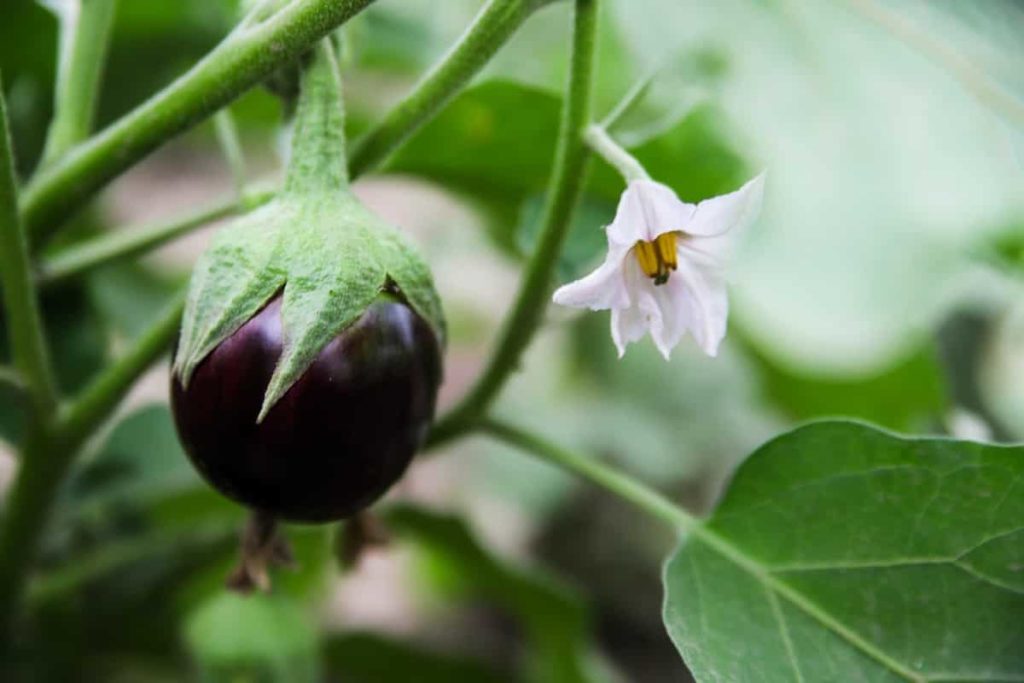
It is a perennial but is grown commercially as an annual crop. Brinjal cultivation and production are the most cost-effective in the world and are practiced in many different ways. Let’s discuss the top 15 steps/ways to boost Eggplant/Brinjal yield below.
Top 15 steps/ways to boost Eggplant/Brinjal yield
Step 1: Brinjal varieties for high yield
- Round Purple Brinjal Varieties: Pusa Hybrid 6, Arka Navaneeth, Mahyco Hybrid 2
- Cluster Purple Varieties: Mahyco hybrid no 3, Mahycoravayya
- Purple long varieties: Gulabi and MS-172
Pusa Purple Long – This is an additional early Brinjal variety. It is ready to pick in about 75-80 days of sowing in autumn and winter and 100-110 days in spring and summer. It is a heavy producer. The average output is 300 quintals/hectare.
Pusa Hybrid-5 – Plants are vigorous, non-pruned, with semi-straight branches. The fruits are long, shiny, attractive, and dark purple with partially colored peduncles weighing about 100 grams. It takes 80-85 days from sowing to the first masonry. It is an early hybrid and high yielding (510 quintals/hectare).
Arka Navneet: This is one of the high-yielding Brinjal varieties. The average output is 650-750 quintals/hectare. In addition, the fruits are dark purple, shiny and oval.
Punjab Bahar: Round fruit variety which comes with dark purple fruits. In addition, this variety is suitable for cultivation in February and March.
In case you missed it: Fertilizer Management in Brinjal/Eggplant: Organic, Compost, How and When to Apply
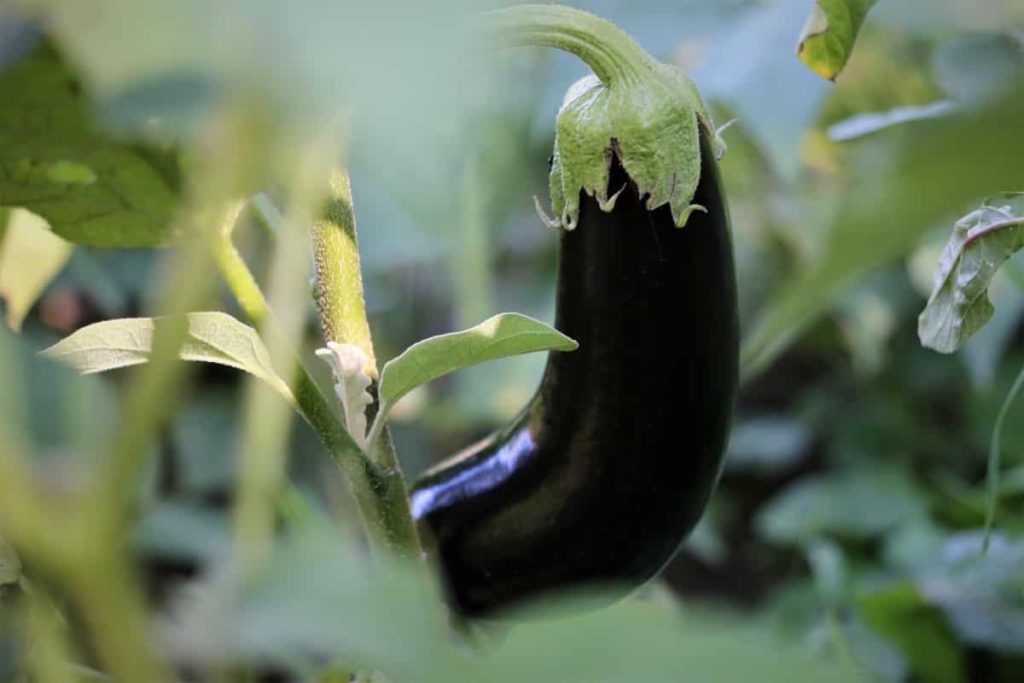
Arka Nidhi: It is also a high-yielding variety that bears fruit in clusters. However, the fruits are greenish-purple. They are considered the best for cooking.
Step 2: Season to get the best yield of Brinjal
Brinjal is a warm-season crop, so it is sensitive to extreme cold. In cold weather, low temperatures cause fruit deformation. A long and warm growing season is essential for successful Brinjal production. Cold nights and short summers are not conducive to good production. The average daily temperature is 13 to 21°C, suitable for maximum growth and production. Brinjal seeds grow well at 25°C.
Step 3: Soil and field preparation suitable for maximum growth and production
Brinjal can be grown in any soil, from light sand to heavy soil. Light soils are good for early production, while clay and silt loam are suitable for high yields. Normal and high-quality loam and sandy soils are best suited for Brinjal cultivation. Brinjal is a very hardy crop and can be grown even in adverse conditions such as Brinjal is highly adaptable in high pH soils because the crop stays in the field for many months.
Plowing about 4 to 5 times before planting requires the soil to be well prepared. Large organic fertilizers such as well-decomposed masses or fertilizers should be added evenly to the soil. Sandy loam soils are best for early crops, and loamy soils for high yields.
Step 4: Land preparation for successful Brinjal production
Four to five plows are used between two plows to move the field into a fine field. Planning should be done for proper leveling. The field is then divided into channels and beds. Well-decomposed FYM is well incorporated in soil preparation.
Step 5: Plant spacing to get a higher yield
Spacing depends on the varieties grown and the planting season. Generally, long fruit varieties are planted at 60 x 45 cm, round varieties at 75 x 60 cm, and high-yielding varieties at 90 x 90 cm. Plants are grafted into skins in light soils and gravel in heavy soils. Pre-soaking irrigation is given 3-4 days before transplanting. At the time of transplantation, plant roots should be dipped in a solution of Bavistin (2 grams per liter of water). Transplantation must be done preferably in the evening.
Step 6: When and how will plant Brinjal for higher yields?
Brinjal seeds are ready within 30 to 35 days of planting. Planting can start when the plants’ height is 12 to 15 cm and 3 to 4 leaves appear. The transplant can begin in the second week of July. When transplanting, ensure that the distance between the two plants is at least one meter.
An average of 7000 saplings can be planted per acre. One acre of Brinjal can produce about 120 quintals of Brinjal. There are good wide varieties of Brinjal that can be sown. You can sow Pursa Pearler, Anmol, Pusa Purple, Ground Pusa, and Hybrid-6 species.
In case you missed it: Growing Eggplant from Seeds – At Home
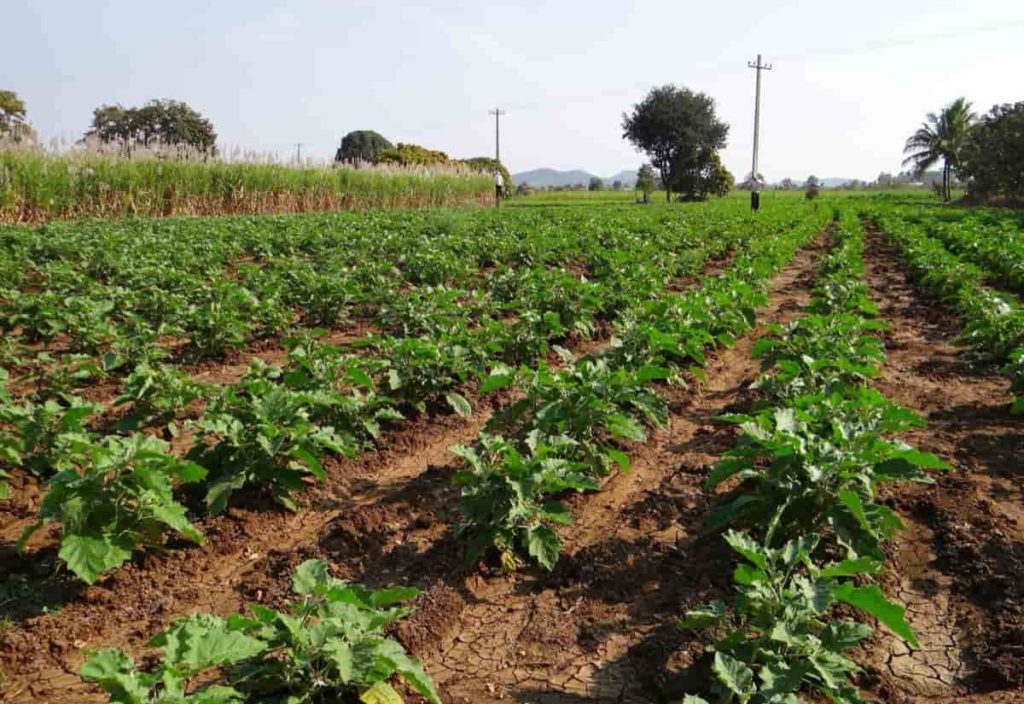
Step 7: Pruning for more fruit production
If you want to get good fruit yield, a little trimming will help you along the way. You can do this when the plant first flowers. You will see two or three main branches protruding from the main stem. Typically, the first flower forms around the crotch, where the plant’s branches emerge from the main stem. Cut off any leaves and stems under this crotch.
The rest of the growth above this point will continue to produce flowers. You may have to re-growth any suckers below this point throughout the season. Also, cut off any yellow leaves. You want to encourage the plant to put its energy into fruiting instead of growing more plants.
Step 8: Brinjal flower drying out and falling off
- Nutrient Deficiencies
- Watering Problems
- Temperature Problems
- Lack of pollination
Brinjal has flowers, but no fruit is caused by one of the two problems. The first thing that can cause Brinjal flowers to fall is lack of water, and the second is lack of pollination.
Brinjal flowers are drying up due to lack of water – When the Brinjal plant is under-stressed, its flowers wither and fall off without producing fruit. The most common cause of Brinjal stress is dehydration. Your Brinjal needs at least 2 inches of water a week in warmer weather. Most of this water should be supplied in one water so that it goes deep into the ground and is less to evaporate quickly.
Deep watering encourages plants to grow deeper roots, which helps them find deeper water in the soil and even meets their watering needs, so a Brinjal flower is less likely to fall. Brinjal flowers are drying up due to lack of pollination – An Brinjal flower is usually wind-pollinated, meaning it does not rely on insects such as bees and moths to pollinate. Pollination problems can occur when the weather is too wet, humid, or hot.
When the air is very humid, the pollen Brinjal flower becomes very sticky due to moisture, and it cannot fall on the pistil to pollinate the flower. When the weather is very hot, pollen becomes inactive because the plant feels it cannot withstand the pressure of extra fruit in hot weather. The plant removes the flower so it does not put more pressure on itself.
Step 9: Fertilizer and manures for more plant growth
Brinjal is a heavy feeder crop. Therefore, the balanced use of fertilizers and manure is essential for successful crop production. In addition, Brinjal is a long-term crop that requires a good amount of fertilizer and manure. When preparing the field, add rotten farmyard manure or compost (200-250 quintal/hectare). The Brinjal crop requires a high fertilizer amount with 100-120 kg nitrogen and 50-60 kg phosphorus and potash hybrid.
The full dose of phosphorus, potash, and half is added at the last field preparation before transplantation, and the remaining amount of N as urea is applied in two to three parts in transplants 30, 45, and 60 in the form of top dressing. Brinjals prefer well-drained, sandy soils that are rich in minerals, especially nitrogen and phosphorus, during the fruiting stage of the plant. Other important elements include potassium, phosphorus, and magnesium. You can add all these elements to the soil by adding organic fertilizer regularly.
In case you missed it: Mulching Brinjal Plants (Eggplants) Organically/Inorganically
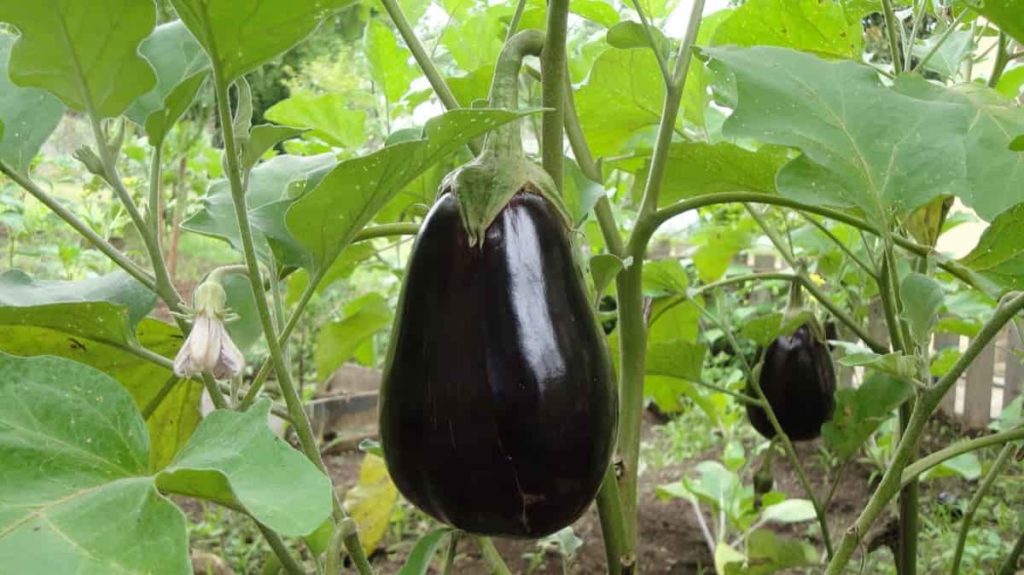
Brinjal plants can grow in almost any type of soil. They grow best in well-drained silt loam or loamy soils. Plants are hardy and can grow with minimal nutrients. Sometimes, during too much flowering, without enough nutrients, the plant drops the flowers without producing fruit to save food for survival. It is most noticeable when the soil is deficient in nitrogen and phosphorus. When the soil is deficient in nitrogen, the leaves turn yellow.
Nitrogen helps plant growth and is essential to growth and fruit formation. Therefore, nitrogen deficiency can prevent fruit formation. Add organic manure such as cow dung or any fertilizer to growing plants. Worm compost can also be added to growing plants to provide enough nutrients. NPK fertilizer can also be used. Excess or lack of fertilizer can affect plant growth.
Step 10: Reasons for Brinjals are not producing fruit
Brinjals become stressed and stop producing fruit for several reasons, mainly insufficient water and temperatures above 32°C. In addition to dry conditions, flowers can fall due to cold weather, pollen problems, soil deficiencies, or pest damage. Brinjals are especially thirsty plants and do not do well in dry spells. Lack of water causes the plant to become stressed, which can cause the flowers to fall off and not bear fruit.
Step 11: Provide timely feeding for more yield
About six weeks after planting, they benefit from the extra nutrients when the plants open and bear their first fruit. You can side-dress the plants with organic manure or compost or soak them deep with water-soluble plant food.
Brinjals grown from containers require almost constant feeding, although you should be careful not to accumulate too much salt, which can cause plant growth to stop. Soak the pots in clean water every two weeks or more to flush out the accumulated salts—organic fertilizers based on fish or kelp release fewer salts than most synthetic products.
In case you missed it: Brinjal Seed Germination (Eggplant) Procedure
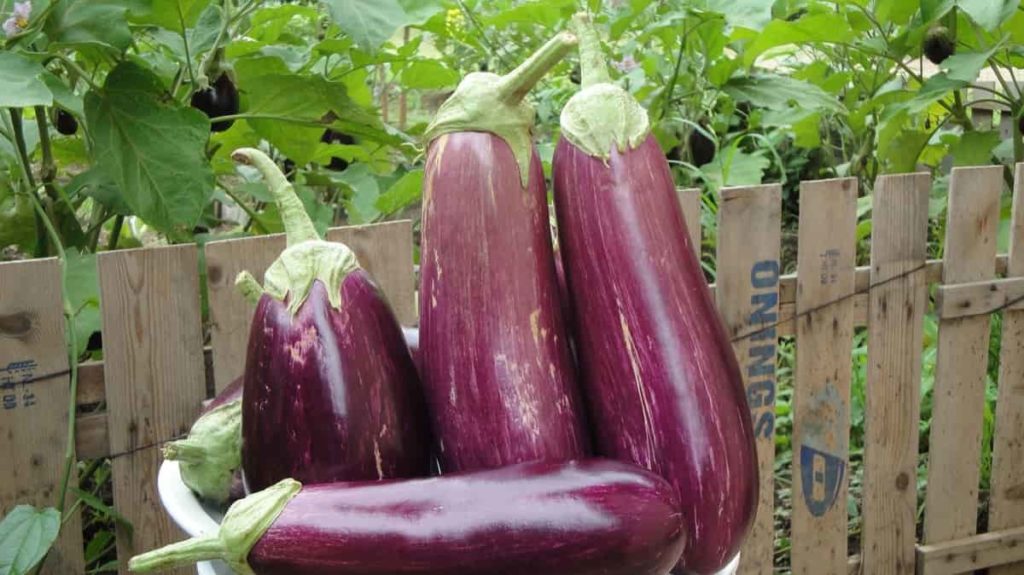
Step 12: Irrigation for fruit arrangement and growth
Irrigation of the field as required by the crop for good growth. Timely irrigation is essential for good fruit growth, flowering, fruit arrangement, and growth. Higher yields can be achieved under maximum moisture levels and fertile soil conditions. The plains should be irrigated every third to fourth day in hot weather and every 7 to 12 days in winter. Irrigation is done before it rains. Brinjal fields should be irrigated regularly to moisten the soil during cold days.
Step 13: Tips to control pests in Brinjal plants
The most harmful insects that like to prey on tender Brinjals are:
- Aphids – They twist the leaves and inhibit plant growth.
- Flea beetles – They usually attack seedlings, but once the plants grow, they can protect themselves.
- Spider mites – They attack in hot weather, make webs across the foliage, and suck plant sap.
Colorado potato beetles and horn moths quickly chew the leaves and can destroy entire crops. You can fight these pests with organic pest control methods, especially mechanical methods. You can spray aphids with water and pick large insects manually. When they are young, protect them from mesh or gardening wool. You can use insecticide soap, neem oil, and other options when all else fails.
Step 14: Harvesting tips for Brinjal growth
The Brinjal should be harvested for the best crop value before it is fully ripe. The demand for such Brinjals is good in the market. But before pruning, you should also pay special attention to its color and size. Remember to harvest only when the Brinjal is smooth and attractive. Harvest and store fruits when they are good in color, marketable in size, but still shiny, immature, and soft. Usually, within 15-19 days, fruits are best ripe for harvest.
In case you missed it: Organic Brinjal Farming (Eggplant), Cultivation Practices
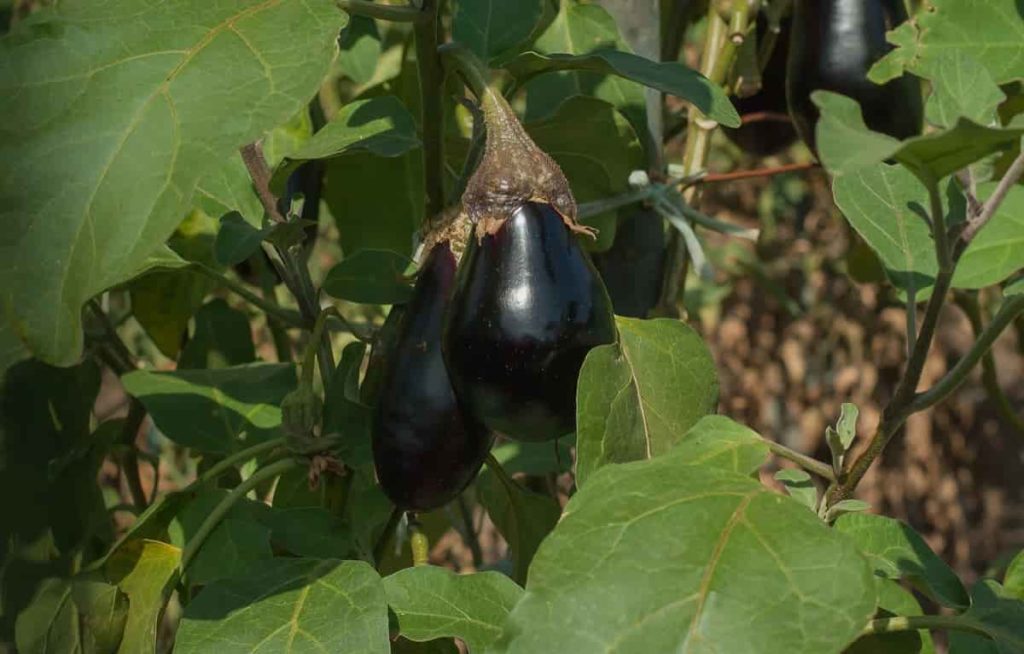
The good quality fruits on the market are shiny, with a shiny appearance, freshness, and perfect size without fading or original color change. The fruits are cut in pairs with stalks. Under normal circumstances, the normal storage life of Brinjal fruit is 1-2 days in the winter months. However, when fruits are stored in cold storage at a temperature of 80-100°C and 85-90% relative humidity, storage life of 2-3 weeks can be achieved.
Step 15: Brinjal yield per hectare
Yield varies from season to season, variety, and location to location. However, healthy Brinjal fruits can usually be obtained from 250 to 500 quintals per hectare.
- How to Make Houseplants Bushy: Effective Tips and Ideas
- Innovative Strategies for Boosting Coconut Pollination and Yield
- Pollination Strategies for Maximum Pumpkin Yield
- The Complete Guide to Chicken Fattening: Strategies for Maximum Growth
- Natural Solutions for Tulip Problems: 100% Effective Remedies for Leaf and Bulb-Related Issues
- Revolutionizing Citrus Preservation: Towards a Healthier, Greener Future
- Natural Solutions for Peony Leaf and Flower Problems: 100% Effective Remedies
- Maximizing Profits with Avocado Contract Farming in India: A Comprehensive Guide
- Natural Solutions for Hydrangea Problems: 100% Effective Remedies for Leaf and Flowers
- The Ultimate Guide to Choosing the Perfect Foliage Friend: Bringing Life Indoors
- From Sunlight to Sustainability: 15 Ways to Use Solar Technology in Agriculture
- The Ultimate Guide to Dong Tao Chicken: Exploring from History to Raising
- The Eco-Friendly Makeover: How to Convert Your Unused Swimming Pool into a Fish Pond
- Mastering the Art of Delaware Chicken Farming: Essentials for Healthy Backyard Flocks
- 20 Best Homemade Fertilizers for Money Plant: DIY Recipes and Application Methods
- How to Craft a Comprehensive Free-Range Chicken Farming Business Plan
- Brighten Your Flock: Raising Easter Egger Chickens for Beauty and Bounty
- How to Optimize Your Poultry Egg Farm Business Plan with These Strategies
- Subsidy for Spirulina Cultivation: How Indian Government Schemes Encouraging Spirulina Farmers
- Ultimate Guide to Raising Dominique Chickens: Breeding, Feeding, Egg-Production, and Care
- Mastering the Art of Raising Jersey Giant Chickens: Care, Feeding, and More
- Ultimate Guide to Raising Legbar Chickens: Breeding, Farming Practices, Diet, Egg-Production
- How to Raise Welsummer Chickens: A Comprehensive Guide for Beginners
- How to Protect Indoor Plants in Winter: A Comprehensive Guide
- Ultimate Guide to Grow Bag Gardening: Tips, Tricks, and Planting Ideas for Urban Gardeners
- Guide to Lotus Cultivation: How to Propagate, Plant, Grow, Care, Cost, and Profit
- Agriculture Drone Subsidy Scheme: Government Kisan Subsidy, License, and How to Apply Online
- Ultimate Guide to Raising Araucana Chickens: Breed Profile, Farming Economics, Diet, and Care
- Bringing Hydroponics to Classroom: Importance, Benefits of Learning for School Students
- Ultimate Guide to Raising Polish Chickens: Breed Profile, Farming Economics, Diet, and Care
- Ultimate Guide to Raising Australorp Chickens: Profile, Farming Economics, Egg Production, Diet, and Care
- Silkie Chicken Farming: Raising Practices, Varieties, Egg Production, Diet, and Care
- Sussex Chicken Farming: Raising Practices, Varieties, Egg Production, Diet and Care
- Homemade Feed Formulations for Livestock: Discover Cost-effective Starter to Finisher Feed Recipes
- 20 Best Pig Weight Gain Supplements: Top Swine Weight Gain Formulas
- Ultimate Guide to Elderberry Farming: Propagation, Planting, Yield, Cost, and Profit